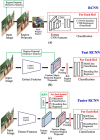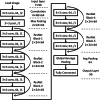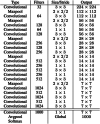Object detection using YOLO: challenges, architectural successors, datasets and applications
- PMID: 35968414
- PMCID: PMC9358372
- DOI: 10.1007/s11042-022-13644-y
Object detection using YOLO: challenges, architectural successors, datasets and applications
Abstract
Object detection is one of the predominant and challenging problems in computer vision. Over the decade, with the expeditious evolution of deep learning, researchers have extensively experimented and contributed in the performance enhancement of object detection and related tasks such as object classification, localization, and segmentation using underlying deep models. Broadly, object detectors are classified into two categories viz. two stage and single stage object detectors. Two stage detectors mainly focus on selective region proposals strategy via complex architecture; however, single stage detectors focus on all the spatial region proposals for the possible detection of objects via relatively simpler architecture in one shot. Performance of any object detector is evaluated through detection accuracy and inference time. Generally, the detection accuracy of two stage detectors outperforms single stage object detectors. However, the inference time of single stage detectors is better compared to its counterparts. Moreover, with the advent of YOLO (You Only Look Once) and its architectural successors, the detection accuracy is improving significantly and sometime it is better than two stage detectors. YOLOs are adopted in various applications majorly due to their faster inferences rather than considering detection accuracy. As an example, detection accuracies are 63.4 and 70 for YOLO and Fast-RCNN respectively, however, inference time is around 300 times faster in case of YOLO. In this paper, we present a comprehensive review of single stage object detectors specially YOLOs, regression formulation, their architecture advancements, and performance statistics. Moreover, we summarize the comparative illustration between two stage and single stage object detectors, among different versions of YOLOs, applications based on two stage detectors, and different versions of YOLOs along with the future research directions.
Keywords: Computer vision; Convolutional neural networks; Deep learning; Object detection; YOLO.
© The Author(s), under exclusive licence to Springer Science+Business Media, LLC, part of Springer Nature 2022, Springer Nature or its licensor holds exclusive rights to this article under a publishing agreement with the author(s) or other rightsholder(s); author self-archiving of the accepted manuscript version of this article is solely governed by the terms of such publishing agreement and applicable law.
Conflict of interest statement
Competing interestsWe do not have any conflict of interest related to the manuscript.
Figures






















Similar articles
-
Comparative Evaluation of Convolutional Neural Network Object Detection Algorithms for Vehicle Detection.J Imaging. 2024 Jul 5;10(7):162. doi: 10.3390/jimaging10070162. J Imaging. 2024. PMID: 39057733 Free PMC article.
-
Automatic Target Detection from Satellite Imagery Using Machine Learning.Sensors (Basel). 2022 Feb 2;22(3):1147. doi: 10.3390/s22031147. Sensors (Basel). 2022. PMID: 35161892 Free PMC article.
-
Training-Based Methods for Comparison of Object Detection Methods for Visual Object Tracking.Sensors (Basel). 2018 Nov 16;18(11):3994. doi: 10.3390/s18113994. Sensors (Basel). 2018. PMID: 30453520 Free PMC article.
-
A comprehensive review of methods based on deep learning for diabetes-related foot ulcers.Front Endocrinol (Lausanne). 2022 Aug 8;13:945020. doi: 10.3389/fendo.2022.945020. eCollection 2022. Front Endocrinol (Lausanne). 2022. PMID: 36004341 Free PMC article. Review.
-
A review on modern defect detection models using DCNNs - Deep convolutional neural networks.J Adv Res. 2021 Apr 23;35:33-48. doi: 10.1016/j.jare.2021.03.015. eCollection 2022 Jan. J Adv Res. 2021. PMID: 35024194 Free PMC article. Review.
Cited by
-
Real-time visual intelligence for defect detection in pharmaceutical packaging.Sci Rep. 2024 Aug 13;14(1):18811. doi: 10.1038/s41598-024-69701-z. Sci Rep. 2024. PMID: 39138256 Free PMC article.
-
Object Detection in Adverse Weather for Autonomous Driving through Data Merging and YOLOv8.Sensors (Basel). 2023 Oct 14;23(20):8471. doi: 10.3390/s23208471. Sensors (Basel). 2023. PMID: 37896564 Free PMC article.
-
Automated detection and localization of pericardial effusion from point-of-care cardiac ultrasound examination.Med Biol Eng Comput. 2023 Aug;61(8):1947-1959. doi: 10.1007/s11517-023-02855-6. Epub 2023 May 27. Med Biol Eng Comput. 2023. PMID: 37243852 Free PMC article.
-
LGR-Net: A Lightweight Defect Detection Network Aimed at Elevator Guide Rail Pressure Plates.Sensors (Basel). 2025 Mar 10;25(6):1702. doi: 10.3390/s25061702. Sensors (Basel). 2025. PMID: 40292798 Free PMC article.
-
Overlapping Shoeprint Detection by Edge Detection and Deep Learning.J Imaging. 2024 Jul 31;10(8):186. doi: 10.3390/jimaging10080186. J Imaging. 2024. PMID: 39194975 Free PMC article.
References
-
- Agarwal S, Terrail JO, Jurie F (2018) Recent advances in object detection in the age of deep convolutional neural networks. arXiv preprint arXiv:1809.03193. 10.48550/arXiv.1809.03193
-
- Albelwi S, Mahmood A. A framework for designing the architectures of deep convolutional neural networks. Entropy. 2017;19(6):242. doi: 10.3390/e19060242. - DOI
-
- Bengio Y, Courville AC, Vincent P (2012) Unsupervised feature learning and deep learning: a review and new perspectives. CoRR, abs/1206.5538, 1(2665)
-
- Bochkovskiy A, Wang CY, Liao HY (2020) YOLOv4: optimal speed and accuracy of object detection. arXiv preprint arXiv:2004.10934
LinkOut - more resources
Full Text Sources
Other Literature Sources
Research Materials
